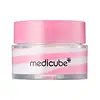What's inside
What's inside
 Key Ingredients
Key Ingredients

 Benefits
Benefits

 Concerns
Concerns

 Ingredients Side-by-side
Ingredients Side-by-side

Diisostearyl Malate
EmollientPhytosteryl/Isostearyl/Cetyl/Stearyl/Behenyl Dimer Dilinoleate
Skin ConditioningPolyisobutene
Butyrospermum Parkii Butter
Skin ConditioningHydrogenated Polydecene
EmollientMicrocrystalline Wax
Emulsion StabilisingDipropylene Glycol
HumectantGlycerin
HumectantWater
Skin ConditioningHydrogenated Lecithin
EmulsifyingPolyglyceryl-10 Oleate
Skin ConditioningAdenosine
Skin ConditioningCeresin
Emulsion StabilisingTitanium Dioxide
Cosmetic ColorantCaprylic/Capric Triglyceride
MaskingPolyhydroxystearic Acid
EmulsifyingAlumina
AbrasiveStearic Acid
CleansingBisabolol
MaskingSilica Dimethyl Silylate
EmollientLauryl Polyglyceryl-3 Polydimethylsiloxyethyl Dimethicone
Skin ConditioningAluminum Hydroxide
EmollientCI 73360
Cosmetic ColorantCI 77742
Cosmetic ColorantBlue 1 Lake
Cosmetic ColorantCamellia Japonica Seed Oil
EmollientSodium Dna
Skin ConditioningTocopherol
AntioxidantButylene Glycol
Humectant1,2-Hexanediol
Skin ConditioningHydrolyzed Collagen
EmollientAkebia Quinata Extract
Skin ConditioningCaprylyl/Capryl Glucoside
CleansingCamellia Japonica Flower Extract
EmollientPolyglyceryl-10 Laurate
Skin ConditioningPropanediol
SolventAcetyl Hexapeptide-8
HumectantAcetyl Tetrapeptide-5
HumectantCarnosine
Skin ConditioningPalmitoyl Tetrapeptide-7
Skin ConditioningPalmitoyl Tripeptide-5
Skin ConditioningYeast Beta-Glucan
Skin ConditioningDiisostearyl Malate, Phytosteryl/Isostearyl/Cetyl/Stearyl/Behenyl Dimer Dilinoleate, Polyisobutene, Butyrospermum Parkii Butter, Hydrogenated Polydecene, Microcrystalline Wax, Dipropylene Glycol, Glycerin, Water, Hydrogenated Lecithin, Polyglyceryl-10 Oleate, Adenosine, Ceresin, Titanium Dioxide, Caprylic/Capric Triglyceride, Polyhydroxystearic Acid, Alumina, Stearic Acid, Bisabolol, Silica Dimethyl Silylate, Lauryl Polyglyceryl-3 Polydimethylsiloxyethyl Dimethicone, Aluminum Hydroxide, CI 73360, CI 77742, Blue 1 Lake, Camellia Japonica Seed Oil, Sodium Dna, Tocopherol, Butylene Glycol, 1,2-Hexanediol, Hydrolyzed Collagen, Akebia Quinata Extract, Caprylyl/Capryl Glucoside, Camellia Japonica Flower Extract, Polyglyceryl-10 Laurate, Propanediol, Acetyl Hexapeptide-8, Acetyl Tetrapeptide-5, Carnosine, Palmitoyl Tetrapeptide-7, Palmitoyl Tripeptide-5, Yeast Beta-Glucan
Polybutene
Dipentaerythrityl Hexahydroxystearate/Hexastearate/Hexarosinate
Skin ConditioningDiisostearyl Malate
EmollientRicinus Communis Seed Oil
MaskingOctyldodecanol
EmollientMethyl Hydrogenated Rosinate
PerfumingCeresin
Emulsion StabilisingSynthetic Wax
AbrasivePyrus Malus Seed Oil
EmollientCamellia Japonica Seed Oil
EmollientCopernicia Cerifera Wax
Calophyllum Inophyllum Seed Oil
AntimicrobialCocos Nucifera Oil
MaskingPersea Gratissima Oil
Skin ConditioningAnanas Sativus Fruit Extract
Skin ConditioningCarica Papaya Fruit Extract
Skin ConditioningGarcinia Mangostana Peel Extract
Skin ConditioningMangifera Indica Fruit Extract
Skin ConditioningMorinda Citrifolia Extract
AstringentMusa Sapientum Fruit Extract
Skin ConditioningNephelium Lappaceum Branch/Fruit/Leaf Extract
Skin ConditioningPsidium Guajava Fruit Extract
AstringentHydrogenated Castor Oil
EmollientEthylene/Propylene Copolymer
AbrasiveBeeswax
Emulsion StabilisingDisteardimonium Hectorite
StabilisingTocopherol
AntioxidantPropylene Carbonate
SolventPolyglyceryl-2 Triisostearate
EmulsifyingCaprylic/Capric Triglyceride
MaskingDehydroacetic Acid
PreservativeParfum
MaskingCI 77492
Cosmetic ColorantCI 77491
Cosmetic ColorantCI 77499
Cosmetic ColorantPolybutene, Dipentaerythrityl Hexahydroxystearate/Hexastearate/Hexarosinate, Diisostearyl Malate, Ricinus Communis Seed Oil, Octyldodecanol, Methyl Hydrogenated Rosinate, Ceresin, Synthetic Wax, Pyrus Malus Seed Oil, Camellia Japonica Seed Oil, Copernicia Cerifera Wax, Calophyllum Inophyllum Seed Oil, Cocos Nucifera Oil, Persea Gratissima Oil, Ananas Sativus Fruit Extract, Carica Papaya Fruit Extract, Garcinia Mangostana Peel Extract, Mangifera Indica Fruit Extract, Morinda Citrifolia Extract, Musa Sapientum Fruit Extract, Nephelium Lappaceum Branch/Fruit/Leaf Extract, Psidium Guajava Fruit Extract, Hydrogenated Castor Oil, Ethylene/Propylene Copolymer, Beeswax, Disteardimonium Hectorite, Tocopherol, Propylene Carbonate, Polyglyceryl-2 Triisostearate, Caprylic/Capric Triglyceride, Dehydroacetic Acid, Parfum, CI 77492, CI 77491, CI 77499
 Reviews
Reviews

Ingredients Explained
These ingredients are found in both products.
Ingredients higher up in an ingredient list are typically present in a larger amount.
Camellia Japonica Seed Oil comes from the Japanese Camellia plant. This plant is native to East Asia and known as "Tsubaki" in Japanese.
Camellia Japonica Seed Oil is rich in oleic acid. This makes it a great emollient. Emollients help soften and soothe the skin by forming a barrier. This barrier traps moisture within, keeping your skin hydated.
This ingredient is an emollient, solvent, and texture enhancer. It is considered a skin-softener by helping the skin prevent moisture loss.
It helps thicken a product's formula and makes it easier to spread by dissolving clumping compounds.
Caprylic Triglyceride is made by combining glycerin with coconut oil, forming a clear liquid.
While there is an assumption Caprylic Triglyceride can clog pores due to it being derived from coconut oil, there is no research supporting this.
Learn more about Caprylic/Capric TriglycerideCeresin is a wax derived from ozokerite. It is an alternative to beeswax.
The most common process of creating ceresin is by using heat and sulfuric acid.
Diisostearyl Malate is an emollient and most often used in lip products. It comes from isostearyl alcohol, a fatty acid, and malic acid, an AHA.
As an emollient, Diisostearyl Malate helps create a thin film on your skin to trap moisture in. This helps keep your skin soft and smooth.
Tocopherol (also known as Vitamin E) is a common antioxidant used to help protect the skin from free-radicals and strengthen the skin barrier. It's also fat soluble - this means our skin is great at absorbing it.
Vitamin E also helps keep your natural skin lipids healthy. Your lipid skin barrier naturally consists of lipids, ceramides, and fatty acids. Vitamin E offers extra protection for your skin’s lipid barrier, keeping your skin healthy and nourished.
Another benefit is a bit of UV protection. Vitamin E helps reduce the damage caused by UVB rays. (It should not replace your sunscreen). Combining it with Vitamin C can decrease sunburned cells and hyperpigmentation after UV exposure.
You might have noticed Vitamin E + C often paired together. This is because it is great at stabilizing Vitamin C. Using the two together helps increase the effectiveness of both ingredients.
There are often claims that Vitamin E can reduce/prevent scarring, but these claims haven't been confirmed by scientific research.
Learn more about Tocopherol